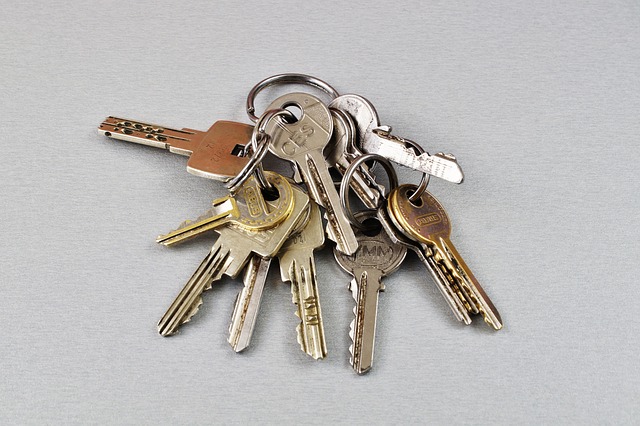Implementing electronic door locks requires understanding and adhering to regional regulations like GDPR and industry standards set by building codes and security associations. Key security standards include ISO 27001, PCI DSS for payment data, HIPAA for healthcare, and UL safety certifications. Effective access control involves data encryption, multi-factor auth, regular protocol updates, and real-time monitoring to detect anomalies and unauthorized access, enhancing both physical and digital security.
In today’s digital age, secure electronic door lock systems are becoming increasingly prevalent. As these innovative solutions transform access control, understanding regulatory compliance is paramount. This article delves into the intricacies of navigating regulations specific to electronic door locks, highlighting key security standards and best practices. By exploring effective access control measures and continuous monitoring strategies, businesses can ensure their electronic door lock systems meet stringent requirements while fostering secure operations.
Understanding Electronic Door Lock Regulations
Electronic door lock systems, while offering advanced security features, must adhere to a set of regulations designed to ensure safety and privacy for users. Understanding these regulations is crucial for any business or individual implementing such technology. The first step involves identifying relevant laws and standards specific to electronic door locks, which can vary based on location. For instance, in many regions, data protection regulations like GDPR (General Data Protection Regulation) govern how personal information collected by these systems should be handled.
Additionally, industry-specific standards may apply, such as those set by building codes or security associations. These standards often dictate performance requirements for electronic door locks, including durability, encryption protocols for communication, and access control mechanisms. Staying informed about these regulations is essential to avoid legal complications and ensure the reliable operation of electronic door lock systems.
Key Security Standards to Meet Compliance
To achieve regulatory compliance for secure electronic door lock systems, several key security standards must be met. These standards are crucial in ensuring that the electronic door locks function reliably and protect sensitive data. One of the primary standards is the International Organization for Standardization (ISO) 27001, which provides a framework for information security management systems. This standard helps ensure that the lock system has robust security measures in place to safeguard user data and prevent unauthorized access.
Additionally, electronic door locks should adhere to industry-specific regulations like the Payment Card Industry Data Security Standard (PCI DSS) if they are used in commercial settings handling payment card data. For healthcare facilities, compliance with the Health Insurance Portability and Accountability Act (HIPAA) is essential to protect patient information. Other relevant standards include those related to physical security, such as UL (Underwriters Laboratories) safety certifications, which verify the lock system’s durability and performance under various conditions.
Implementing Effective Access Control Measures
Implementing effective access control measures is paramount for securing electronic door lock systems. These advanced technologies, designed to enhance security and convenience, come with a responsibility to adhere to stringent regulatory frameworks. By integrating robust access control protocols, businesses can ensure that only authorized individuals gain entry, protecting sensitive areas and valuable assets.
Electronic door locks play a pivotal role in contemporary security strategies, offering features like remote access, biometric authentication, and smart key management. However, it’s crucial to align these innovations with data privacy standards, such as GDPR or industry-specific regulations. This involves encrypting data transmissions, implementing multi-factor authentication, and regularly updating security protocols to counter emerging threats. A comprehensive approach ensures not only the physical security of premises but also the integrity of digital information associated with access control systems.
Continuous Monitoring for Secure Operations
Electronic door lock systems, with their advanced security features, require continuous monitoring to ensure their effectiveness and reliability. This real-time surveillance is vital for detecting any anomalies or potential breaches in the system’s integrity. By implementing robust monitoring mechanisms, manufacturers can guarantee the secure operations of these locks, ensuring they function as intended.
The process involves constant data analysis, where every transaction and access attempt is meticulously tracked. Advanced algorithms and security protocols are employed to identify unusual patterns, unauthorized access attempts, or any deviations from established norms. This proactive approach allows for immediate response to potential threats, enhancing the overall security posture of buildings and facilities equipped with electronic door locks.
Electronic door lock systems, while offering enhanced security and convenience, must adhere to stringent regulatory frameworks. By understanding relevant standards such as those from UL (Underwriters Laboratories) and NFPA (National Fire Protection Association), implementing robust access control measures, continuously monitoring for vulnerabilities, and staying updated with evolving regulations, businesses can ensure their electronic door locks meet the required security standards. This multi-layered approach is vital to maintaining a secure operating environment, protecting sensitive data, and preventing unauthorized access.
